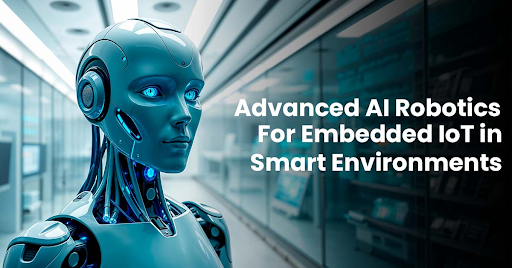
The environment around us from smart homes, smart cities and smart commercial buildings are becoming faster and smarter. These advances come with the convergence of Embedded Software Development Services with AI based robotics and IoT interoperability. Embedded Systems, AI-based computations and sensor networks can now all work together to create a smarter built environment with the ability to sense and respond to change in the environment, in as little as milliseconds.
Autonomous robots traversing warehouse floors, intelligent surveillance systems responding to live activity, building automation that tracks energy usage, embedded AI robotics are transforming the world we live and work in.
Now let’s take a look at the evolution of this intersection, what it requires to be successful, and how Sunstream enables organizations to effectively execute such solutions.
Understanding Embedded AI Robotics in IoT
Embedded AI Robotics refers to machines that have intelligence on board that includes sensors, make choices using AI and act in real-time control systems directly on the device. Unlike cloud configurations, embedded robotics adds an edge of intelligence, so the device itself is processing that data. This means faster reaction time, reduced bandwidth and more reliable systems.
These systems in an IoT ecosystem do more than just carry out commands: they are able to sense the environment, interpret data, and make predictive decisions. A robotic sensor in smart agriculture,
For example, it can record the moisture of soil and its smart algorithms can make an autonomous decision to activate irrigation by taking action only when needed.
Why Embedded Systems are Critical to Smart Robotics
Smart robotics systems must be efficient, compact and capable of executing tasks in real-time and unlike traditional computing, embedded systems are very resource-centric and optimized for a single task so that consistent performance can occur without resource overuse.
This is where Embedded Linux Development Services come in. The combination of scalability, security and device-level control with Linux-based platforms allows for faster development of smart robots where a modular firmware architecture enables smart robots to scale from simple automation tasks to more complex edge machine learning.
Additionally, through Embedded Board Design Services with CAD Drawing Services, manufacturers can easily integrate sensors, microcontrollers and mechanical components into the same design while ensuring that they put all the components into the optimal amount of space (which is critical in drones, surveillance bots, or industrial AMRs – Autonomous Mobile Robots).
AI’s Role: From Reactive to Predictive
While IoT provides connectivity and data, With AI embedded, robots will not only respond but anticipate as well.
Take for example a smart factory robot, the robot can sense changing trends in motor vibration and predict a potential breakdown before the failure takes place. Or the surveillance bots can find irregular movement patterns and notify the authorities in real-time.
These scenarios require rapid processing and real-time execution. They have the support of high performance microcontrollers, clutter free PCB layouts, and discerning firmware, this is where PCB Design Services and embedded software came together flawlessly.
Designing Smarter with Better Data Models
Sophisticated AI-based systems learn and become better through data modeling, in which the 3D Modeling Services contribute to the value of both mechanical design and system design. A designer makes a digital twin of a robot, simulates it in the world, and optimizes mechanics around embedded logic.
As an example, using 3D CAD the designer could create a delivery robot and run it up stairs or incline in the simulations – without having built a single prototype. These early predictive capabilities will save time and enhance safety.
When you add CAD Drafting Services into the mix, integrating them with embedded hardware simulation allows teams to go from concept to product faster. The fit of mechanical form vs. electronic function is what separates clever smart systems from the more experimental ones.
Smart Environments, Real Results
Embedded AI robotics has already changed how environments function:
Smart Retail: Bots that scan shelf inventory manage inventory, change prices and recommend rearrangement.
Smart Healthcare: Autonomous carts that deliver medicines and keep track of patient movement.
Smart Logistics: AI-enabled robots sorting packages and helping to reduce bottlenecks in the supply chain.
Smart Homes: Embedded assistants learning user habits to optimize heating, lighting, and security.
In every case, there are strong foundations, capable hardware, intelligent software, and the interplay between AI and embedded systems.
Smart environments depend on smart systems. As robotics, AI, and IoT converge, it becomes imperative one partners with the right organization to develop embedded intelligence. We have proven experience in Embedded Software Development Services, hardware optimization and design integration allowing development teams to Go Faster, Adapt Quicker, and Operate Smarter. The future is more than connected, it is responsive.
Sunstream is here to fill that gap with Embedded Software Development to fulfill practical design, compliance, and manufacturing. At every stage of a project, from hardware platform selection through to production-ready embedded firmware development, Sunstream can jump in and take the reins.





 +1.585.935.7123
+1.585.935.7123 +91-804-148-6861
+91-804-148-6861